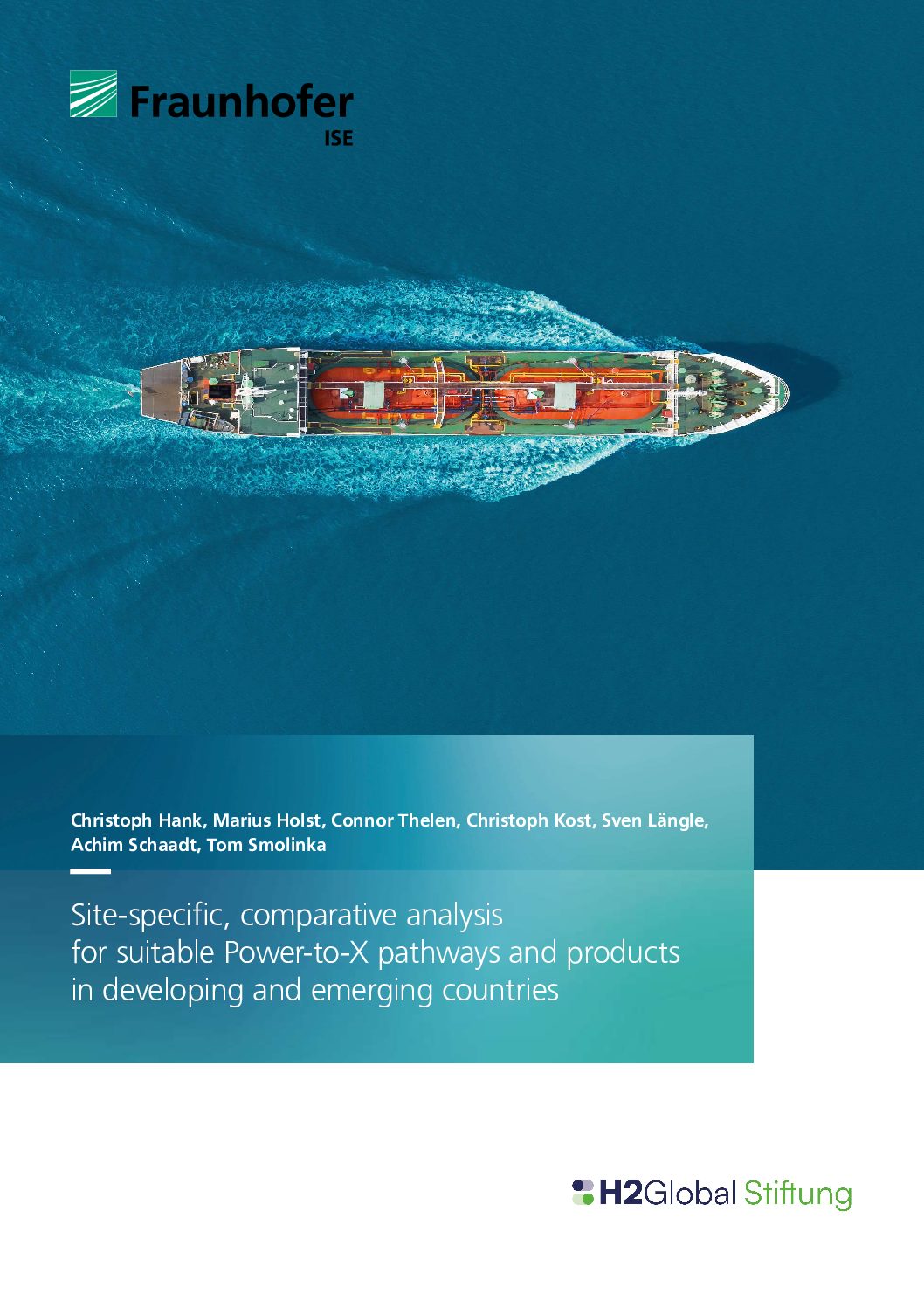
Green hydrogen and its derivatives – ammonia, methanol, and synthetic kerosene – store energy from the sun and wind in order to transfer it efficiently from distant regions to Europe. At the same time, many industries that cannot use electricity directly as an energy source will be dependent on these climate-neutral alternatives to fossil gas and oil in the future. On behalf of the H2Global Foundation, the Fraunhofer Institute for Solar Energy Systems ISE has examined 39 regions in 12 countries preselected by H2Global to determine where the production of such Power-to-X (PtX) products, in conjunction with transport to Germany, would be most cost-effective by 2030. The result: Brazil, Colombia, and Australia offer particularly good conditions for the import of green ammonia, methanol, and kerosene. Imports of gaseous green hydrogen could come from southern Europe or North Africa, provided that pipelines are available in time for transport.
»Sustainably produced hydrogen and its derivatives will be indispensable in certain sectors of the energy system,« says Prof. Dr. Hans-Martin Henning, Director of the Fraunhofer Institute for Solar Systems ISE. »According to our calculations, imports are a necessary and economically viable supplement to local hydrogen production.« Power-to-X projects on the gigawatt scale, which this study considers, entail long planning and construction phases, meaning that implementation of the first large-scale projects in suitable production countries should already be initiated now. According to calculations by Fraunhofer ISE Germany will need both domestically produced and imported Power-to-X energy carriers in at least the single-digit terawatt-hour range by 2030.
»According to our calculations for the 12 countries preselected by H2Global, the local production costs for gaseous green hydrogen are nowhere as low as in Brazil, Australia, or northern Colombia. In these countries, it costs between 96 and 108 euros to produce one megawatt hour of green hydrogen, which works out to around 3.20 to 3.60 euros per kilogram«, says Dr. Christoph Hank, lead author of the study. »If the long-distance transport by ship, in the form of either liquid hydrogen or ammonia, is taken into account, under the best possible conditions the supply costs for Germany are 171 euros per megawatt hour with respect to the energy content of both products«. According to the study, the high combined full load hours for solar and wind energy systems in these countries – and thus the high utilization of the currently still capital-intensive Power-to-X processes – is a key advantage of these countries. A large distance between production and use is not an exclusion criterion for ammonia, methanol, or kerosene due to their high energy density and established ship transport logistics.
An alternative also explored in the study is the import of gaseous hydrogen via pipeline to Germany, with the possibility of subsequent on-site processing to its downstream products. »Regions in Southern Europe and North Africa are the best choices in this scenario,« explains Dr. Christopher Hank. »Provided that the first sections of the pipeline infrastructure are built by 2030, large quantities of sustainably produced hydrogen could then be transported to Europe and thus also to Germany in a very cost-efficient manner.« In the analysis, regions in Algeria, Tunisia, and Spain have the lowest supply costs for gaseous hydrogen, at 137 euros per megawatt hour, including transport in a natural gas pipeline converted to hydrogen. This corresponds to 4.56 euros per kilogram of green hydrogen.
According to the study, the key criteria for cost-efficient Power-to-X generation are an advantageous wind-and-solar energy combination and high system utilization, as well as comparatively low capital costs. »In general, we have found that the combination of good wind and solar power conditions has a very positive effect on the costs of hydrogen production, often more so than when a region only has excellent conditions for either wind or solar power generation,« explains Dr. Christoph Kost, who is responsible for the renewable energy analyses of the Fraunhofer ISE study. »Ultimately, the cheapest possible generation costs for renewable electricity are the decisive factor.« Further significant cost reductions can be expected in the future for renewable energy and hydrogen electrolysis, also through the optimization, scaling, and ramp-up of the entire PtX value chain. The production and import costs of sustainable energy sources should thus continue to fall significantly after 2030.
The techno-economic results of the study are based on extensive analyses of the countries with regard to their potential for generating electricity from renewable energies. The regions identified as promising were then analyzed in a further step with regard to the generation of green hydrogen and its derivates. »The detailed design and optimization of individual Power-to-X parks was then carried out for each region with the help of H2ProSim, a simulation tool for Power-to-X value chains developed by Fraunhofer ISE,« explains Marius Holst, who is responsible at Fraunhofer ISE for the Power-to-X simulations in the study. The authors of the study emphasize that in building a global hydrogen industry, the domestic needs of the future exporting countries for renewable energy and sustainable fuels must also be covered and that the construction of a hydrogen generation and export infrastructure must be done in coordination and agreement with local stakeholders.